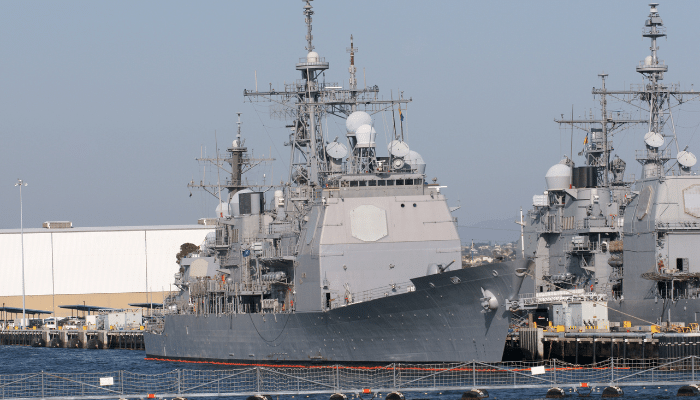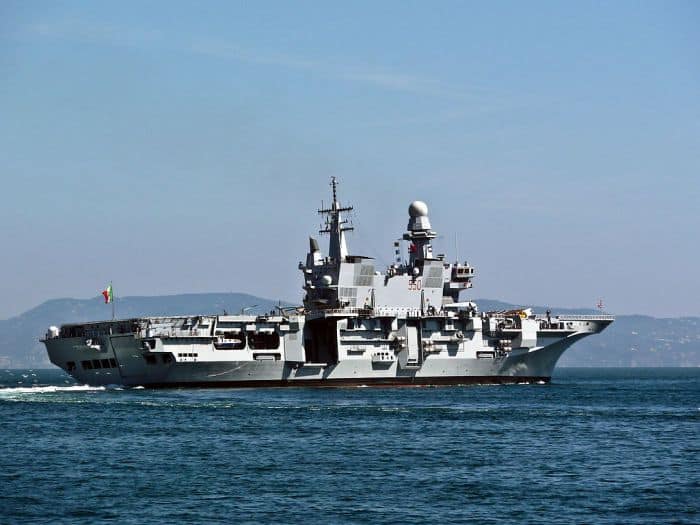Cruisers vs Destroyers: What are the Differences?
Warships constitute a crucial part of surface fleets worldwide, showcasing diverse sizes and capabilities that align with their specific roles and functions. The expansive oceans act as a stage where naval forces globally unveil strategic designs and technological innovations that make their warships distinct.
Cruisers and destroyers emerged as prevalent vessels employed by numerous navies within the array of warship types.
Cruisers, characterised by their substantial size, are constructed for high-speed and extended cruising ranges. In contrast, destroyers, renowned for their swiftness and manoeuvrability, are designed to escort larger vessels within fleets or convoys.
Historically, these two classes of warships held distinct roles within naval fleets. However, the maritime landscape has undergone a profound transformation fueled by technological advancements, ushering in a new era of naval warfare. The infusion of advanced automation, cutting-edge weaponry, and state-of-the-art sensor suites has redefined the traditional traits of cruisers and destroyers and blurred the once clearly defined lines between them.
At the same time, a diverse array of types has emerged under the umbrella of cruisers, each tailored to meet specific strategic objectives. From heavily armed guided-missile cruisers to versatile air defense cruisers, this category has adapted to the evolving demands of contemporary naval operations.
Simultaneously, destroyers have evolved from their original role as torpedo boat destroyers into multifaceted platforms armed with advanced weaponry, boasting unparalleled agility and speed.
Despite the convergence in technological features, these two warship types differ significantly in terms of their roles and functions. To comprehend the full extent of their contributions on the battlefront, let’s delve into the key distinctions between cruisers and destroyers.
1. Origin and Evolution
In contemporary naval operations, both cruisers and destroyers stand as formidable warships, each with a unique historical trajectory and distinct roles in warfare. While the term “cruiser” finds its roots in the age of sail, the history of cruisers began with Britain’s introduction of unarmored ships in the mid-19th century to protect commerce.
By the 1870s, armoured cruisers, belted cruisers, second-class cruisers, and light cruisers entered the scene. The Imperial Russian Navy’s General-Admiral, completed in 1874, is regarded as the first true armoured cruiser.
Conversely, destroyers, conceived as “torpedo boat destroyers” in 1885, evolved to protect battleships from torpedo threats and transformed into super torpedo boats during World War I, serving as crucial scouts for enemy fleets. Launched in 1893, the HMS Havock of the British Royal Navy is recognised as the first ship explicitly designated as a destroyer.
2. Role and responsibilities
Cruisers and destroyers showcase significant differences in their roles within naval operations. Cruisers, designed for long-range and independent missions, often function as command ships defending fleets.
Their agility and extended operational range make them ideal for covering vast areas and collecting vital intelligence on enemy movements. In addition to their scouting duties, their diverse tasks encompass naval gunfire support, air defence, escorting aircraft carriers, and troop transport.
On the other hand, destroyers specialise in protecting the fleet from short-range attackers, focusing on antisubmarine warfare, anti-aircraft defence, and escort missions. Beyond combat roles, some destroyers are equipped for command-and-control functions, coordinating fleet movements, and even participating in search and rescue operations.
3. Size and Design
A notable distinction between cruisers and destroyers lies in their size. Cruisers, typically larger and often the largest ships in the fleet, feature a modern length of about 180 meters and a displacement of 7,000 to 10,000 tons.
The 1992 Washington Treaty imposed a limit of 10,000 tons on cruisers, which many violated, leading to its abandonment shortly before World War II. The Kirov class nuclear-powered guided-missile battlecruisers of the Soviet Navy and Russian Navy are the largest cruisers that are currently in operation.
The Kirov-class battlecruiser boasts an impressive size with a full load displacement of approximately 28,000 tons, a length of around 252 meters, and a beam of about 28.5 meters.
In comparison, destroyers are often designed with greater manoeuvrability, commonly having dimensions such as a length of 190 meters and a full load weight of approximately 8,000 tons.
The title of the largest and most technologically advanced surface combatant worldwide currently belongs to the USS Zumwalt, a guided missile destroyer in the United States Navy. Launched in October 2013, the USS Zumwalt showcases considerable dimensions, featuring a displacement of around 15,000 tons, a length of approximately 183.9 meters, and a width of about 24.6 meters.
4. Armament
While both cruisers and destroyers are designed to provide firepower on the battlefront, they exhibit different capabilities in terms of firepower and armour. Cruisers are typically more heavily armed, equipped with larger caliber main guns, missile launchers, anti-aircraft guns, and anti-ship guns.
Modern destroyers boast armaments such as surface-to-air missiles, antisubmarine torpedoes, anti-ship missiles, and main guns of about 100 or 130 mm in calibre. Some destroyers also carry submarine-hunting helicopters and cruise missiles.
The USS Zumwalt, the most technologically advanced surface warship in the US Navy, features 80 vertical launch cells for missiles with the capability to target both land and sea objectives, including antisubmarine rockets.
5. Independence
Cruisers, designed for open-sea operations and equipped with substantial firepower, have the capability to operate independently.
Traditionally, cruisers, dating back to the 17th century, were known as independent warships involved in scouting, commerce protection, or raiding. Even modern cruisers maintain this independence. In contrast, destroyers are designed to operate in conjunction with other vessels, escorting larger fleets or convoy ships to defend against a range of threats.
Destroyers are intricately crafted for collaborative naval operations, functioning in tandem with other vessels.
Their primary role involves escorting larger fleets or convoy ships and orchestrating a protective shield against a broad spectrum of threats. This collaborative approach ensures a comprehensive defence strategy, leveraging the versatility and firepower of destroyers in conjunction with the capabilities of the overall fleet.
6. Speed and maneuverability
Originally constrained in speed by their size, cruisers have undergone significant evolution. In the present era, modern guided missile cruisers can attain top speeds exceeding 30 knots. In addition to their impressive speeds, cruisers are renowned for their exceptional manoeuvrability, allowing them to navigate swiftly and responsively in various maritime conditions.
In contrast, destroyers, benefiting from their compact size, have consistently demonstrated higher cruising speeds, often reaching a maximum of 35 knots. An exceptional example is the French Navy’s Le Terrible, a large destroyer of the Le Fantasque class, which notably holds the record for the fastest destroyer, achieving an impressive speed of 45.25 knots.
7. Crew Members
Cruisers, distinguished by their substantial size, demand a larger complement of crew members to effectively manage a myriad of intricate systems and weaponry while deployed in foreign waters.
For example, the US Navy’s Baltimore-class cruisers houses an extensive crew of 80 officers and 1500 crewmen during wartime operations. Nevertheless, the landscape of naval operations has undergone a transformative shift due to remarkable strides in automation technology. This has yielded a noteworthy change in crew requirements for contemporary cruisers.
In contrast to their historical counterparts, modern destroyers exemplify this evolution, typically accommodating crews of approximately 300 personnel. A prime illustration of this is observed in the US Navy’s state-of-the-art Arleigh Burke-class destroyers, which boast an impressive crew size of about 300 sailors. This reduction in crew numbers, facilitated by the integration of cutting-edge automation, underscores the evolution of naval vessels towards more streamlined and technologically sophisticated operational frameworks.
8. Endurance at Sea
Crafted with a focus on extended operational endurance, cruisers are purpose-built vessels designed to sustain prolonged periods at sea, rendering them well-suited for extended-range patrols and missions.
Their inherent design incorporates a robust capacity to stock essential provisions, including but not limited to food, fuel, and various supplies, enabling sustained operations over extended durations while deployed at sea. In sharp contrast, destroyers, characterised by their smaller size, exhibit a more limited endurance profile. The constrained physical dimensions of destroyers inherently result in reduced storage capacity, necessitating more frequent resupply and refuelling.
9. Cost and Maintenance
In the realm of naval vessels, cruisers typically take the spotlight as larger and more intricate vessels when compared to their destroyer counterparts. This inherent complexity often translates into higher costs associated with both construction and maintenance. The financial outlay for cruisers is intricately tied to various factors, including the sophistication of weapon systems, the comprehensiveness of radar and sensor suites, and the overall design specifications.
An illustrative case of this financial commitment comes to light with the People’s Liberation Army Navy’s (PLAN) ongoing construction of the Type 055 Renhai-class guided-missile cruisers. Boasting dimensions of 591 feet in length, a 66-foot beam, and a 22-foot draft, these cruisers reportedly come with a price tag of at least $900 million each.
Conversely, destroyers, characterised by their smaller size and more targeted mission objectives, often present a more cost-effective alternative. Nonetheless, it’s crucial to note that even within the realm of destroyers, costs can escalate, particularly when integrating advanced technology and weapon systems.
A case in point is the United States Navy’s cutting-edge Zumwalt-class guided missile destroyers, where the combined expenditure for three of these vessels, encompassing research and development, reportedly amounted to around $22.4 billion.
10. Fleet strength
When it comes to cruiser fleet strength, the United States continues to assert its dominance as the world’s foremost operator, with China now occupying the second spot.
Recent data from the International Institute for Strategic Studies indicates that the US Navy currently commands a fleet of 19 operational cruisers, a significant lead over China’s People’s Liberation Army Navy (PLAN), which operates seven cruisers. Japan follows with three cruisers in its possession. In terms of destroyer capability, the United States Navy once again emerges as the global frontrunner.
According to the latest rankings from GlobalFirepower.com, the US Navy boasts the largest destroyer fleet, commanding a formidable 92 vessels. China secures the second position with 50 destroyers, followed by Japan, which operates 36 destroyers.
You might also like to read-
- Introduction To the Royal Navy’s New Offshore Patrol Vessels
- What is the Difference between Merchant Navy and Defence Navy?
- 10 Massive Crane Ships Operating at the Sea
- Panamax and Aframax Tankers: Oil Tankers with a Difference
Disclaimer: The authors’ views expressed in this article do not necessarily reflect the views of Marine Insight. Data and charts, if used in the article, have been sourced from available information and have not been authenticated by any statutory authority. The author and Marine Insight do not claim it to be accurate nor accept any responsibility for the same. The views constitute only the opinions and do not constitute any guidelines or recommendations on any course of action to be followed by the reader.
The article or images cannot be reproduced, copied, shared or used in any form without the permission of the author and Marine Insight.
Latest Type Of Ships Articles You Would Like:
Do you have info to share with us ? Suggest a correction
Subscribe To Our Newsletters
By subscribing, you agree to our Privacy Policy and may receive occasional deal communications; you can unsubscribe anytime.
Web Stories
























